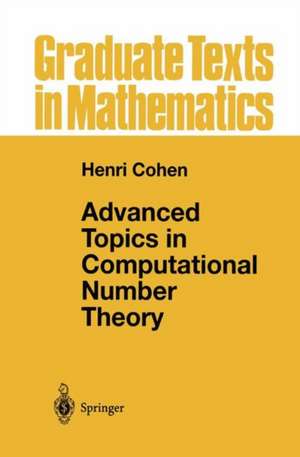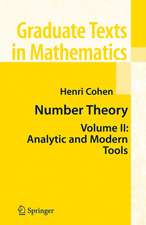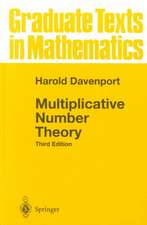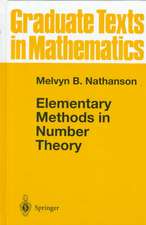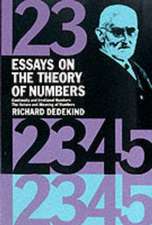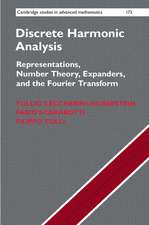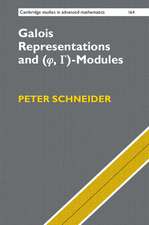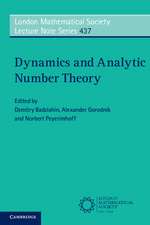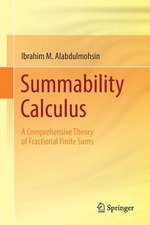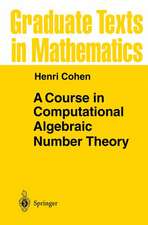Advanced Topics in Computational Number Theory: Graduate Texts in Mathematics, cartea 193
Autor Henri Cohenen Limba Engleză Hardback – 30 noi 1999
| Toate formatele și edițiile | Preț | Express |
|---|---|---|
| Paperback (1) | 505.27 lei 6-8 săpt. | |
| Springer – 13 oct 2012 | 505.27 lei 6-8 săpt. | |
| Hardback (1) | 603.39 lei 6-8 săpt. | |
| Springer – 30 noi 1999 | 603.39 lei 6-8 săpt. |
Din seria Graduate Texts in Mathematics
- 17%
 Preț: 528.68 lei
Preț: 528.68 lei -
 Preț: 402.89 lei
Preț: 402.89 lei -
 Preț: 383.86 lei
Preț: 383.86 lei - 17%
 Preț: 366.57 lei
Preț: 366.57 lei - 17%
 Preț: 398.97 lei
Preț: 398.97 lei -
 Preț: 355.83 lei
Preț: 355.83 lei -
 Preț: 412.25 lei
Preț: 412.25 lei -
 Preț: 404.48 lei
Preț: 404.48 lei -
 Preț: 289.88 lei
Preț: 289.88 lei - 17%
 Preț: 365.80 lei
Preț: 365.80 lei - 17%
 Preț: 359.45 lei
Preț: 359.45 lei - 15%
 Preț: 488.70 lei
Preț: 488.70 lei - 13%
 Preț: 357.76 lei
Preț: 357.76 lei -
 Preț: 407.88 lei
Preț: 407.88 lei - 13%
 Preț: 352.49 lei
Preț: 352.49 lei - 13%
 Preț: 358.86 lei
Preț: 358.86 lei - 13%
 Preț: 393.48 lei
Preț: 393.48 lei - 11%
 Preț: 351.00 lei
Preț: 351.00 lei - 17%
 Preț: 359.58 lei
Preț: 359.58 lei -
 Preț: 350.46 lei
Preț: 350.46 lei - 8%
 Preț: 567.37 lei
Preț: 567.37 lei -
 Preț: 399.74 lei
Preț: 399.74 lei -
 Preț: 498.91 lei
Preț: 498.91 lei - 20%
 Preț: 571.26 lei
Preț: 571.26 lei - 15%
 Preț: 548.81 lei
Preț: 548.81 lei -
 Preț: 498.69 lei
Preț: 498.69 lei - 15%
 Preț: 354.39 lei
Preț: 354.39 lei -
 Preț: 313.11 lei
Preț: 313.11 lei - 13%
 Preț: 427.40 lei
Preț: 427.40 lei - 17%
 Preț: 363.60 lei
Preț: 363.60 lei -
 Preț: 340.19 lei
Preț: 340.19 lei - 17%
 Preț: 364.47 lei
Preț: 364.47 lei - 17%
 Preț: 366.47 lei
Preț: 366.47 lei - 17%
 Preț: 366.07 lei
Preț: 366.07 lei -
 Preț: 247.59 lei
Preț: 247.59 lei - 17%
 Preț: 367.70 lei
Preț: 367.70 lei - 13%
 Preț: 356.80 lei
Preț: 356.80 lei - 17%
 Preț: 398.78 lei
Preț: 398.78 lei - 17%
 Preț: 398.51 lei
Preț: 398.51 lei - 17%
 Preț: 496.65 lei
Preț: 496.65 lei - 13%
 Preț: 361.80 lei
Preț: 361.80 lei - 15%
 Preț: 482.97 lei
Preț: 482.97 lei -
 Preț: 402.02 lei
Preț: 402.02 lei - 17%
 Preț: 366.57 lei
Preț: 366.57 lei - 20%
 Preț: 449.74 lei
Preț: 449.74 lei -
 Preț: 380.35 lei
Preț: 380.35 lei -
 Preț: 364.80 lei
Preț: 364.80 lei
Preț: 603.39 lei
Preț vechi: 709.87 lei
-15% Nou
Puncte Express: 905
Preț estimativ în valută:
115.47€ • 125.39$ • 96.100£
115.47€ • 125.39$ • 96.100£
Carte tipărită la comandă
Livrare economică 22 aprilie-06 mai
Preluare comenzi: 021 569.72.76
Specificații
ISBN-13: 9780387987279
ISBN-10: 0387987274
Pagini: 581
Ilustrații: XV, 581 p.
Dimensiuni: 155 x 235 x 32 mm
Greutate: 0.96 kg
Ediția:2000
Editura: Springer
Colecția Springer
Seria Graduate Texts in Mathematics
Locul publicării:New York, NY, United States
ISBN-10: 0387987274
Pagini: 581
Ilustrații: XV, 581 p.
Dimensiuni: 155 x 235 x 32 mm
Greutate: 0.96 kg
Ediția:2000
Editura: Springer
Colecția Springer
Seria Graduate Texts in Mathematics
Locul publicării:New York, NY, United States
Public țintă
GraduateCuprins
1. Fundamental Results and Algorithms in Dedekind Domains.- 1.1 Introduction.- 1.2 Finitely Generated Modules Over Dedekind Domains.- 1.3 Basic Algorithms in Dedekind Domains.- 1.4 The Hermite Normal Form Algorithm in Dedekind Domains.- 1.5 Applications of the HNF Algorithm.- 1.6 The Modular HNF Algorithm in Dedekind Domains.- 1.7 The Smith Normal Form Algorithm in Dedekind Domains.- 1.8 Exercises for Chapter 1.- 2. Basic Relative Number Field Algorithms.- 2.1 Compositum of Number Fields and Relative and Absolute Equations.- 2.2 Arithmetic of Relative Extensions.- 2.3 Representation and Operations on Ideals.- 2.4 The Relative Round 2 Algorithm and Related Algorithms.- 2.5 Relative and Absolute Representations.- 2.6 Relative Quadratic Extensions and Quadratic Forms.- 2.7 Exercises for Chapter 2.- 3. The Fundamental Theorems of Global Class Field Theory.- 3.1 Prologue: Hilbert Class Fields.- 3.2 Ray Class Groups.- 3.3 Congruence Subgroups: One Side of Class Field Theory.- 3.4 Abelian Extensions: The Other Side of Class Field Theory.- 3.5 Putting Both Sides Together: The Takagi Existence Theorem 154.- 3.6 Exercises for Chapter 3.- 4. Computational Class Field Theory.- 4.1 Algorithms on Finite Abelian groups.- 4.2 Computing the Structure of (?K/m)*.- 4.3 Computing Ray Class Groups.- 4.4 Computations in Class Field Theory.- 4.5 Exercises for Chapter 4.- 5. Computing Defining Polynomials Using Kummer Theory.- 5.1 General Strategy for Using Kummer Theory.- 5.2 Kummer Theory Using Hecke’s Theorem When ?? ? K.- 5.3 Kummer Theory Using Hecke When ?? ? K.- 5.4 Explicit Use of the Artin Map in Kummer Theory When ?n ? K.- 5.5 Explicit Use of the Artin Map When ?n ? K.- 5.6 Two Detailed Examples.- 5.7 Exercises for Chapter 5.- 6. Computing Defining PolynomialsUsing Analytic Methods.- 6.1 The Use of Stark Units and Stark’s Conjecture.- 6.2 Algorithms for Real Class Fields of Real Quadratic Fields.- 6.3 The Use of Complex Multiplication.- 6.4 Exercises for Chapter 6.- 7. Variations on Class and Unit Groups.- 7.1 Relative Class Groups.- 7.2 Relative Units and Regulators.- 7.3 Algorithms for Computing Relative Class and Unit Groups.- 7.4 Inverting Prime Ideals.- 7.5 Solving Norm Equations.- 7.6 Exercises for Chapter 7.- 8. Cubic Number Fields.- 8.1 General Binary Forms.- 8.2 Binary Cubic Forms and Cubic Number Fields.- 8.3 Algorithmic Characterization of the Set U.- 8.4 The Davenport-Heilbronn Theorem.- 8.5 Real Cubic Fields.- 8.6 Complex Cubic Fields.- 8.7 Implementation and Results.- 8.8 Exercises for Chapter 8.- 9. Number Field Table Constructions.- 9.1 Introduction.- 9.2 Using Class Field Theory.- 9.3 Using the Geometry of Numbers.- 9.4 Construction of Tables of Quartic Fields.- 9.5 Miscellaneous Methods (in Brief).- 9.6 Exercises for Chapter 9.- 10. Appendix A: Theoretical Results.- 10.1 Ramification Groups and Applications.- 10.2 Kummer Theory.- 10.3 Dirichlet Series with Functional Equation.- 10.4 Exercises for Chapter 10.- 11. Appendix B: Electronic Information.- 11.1 General Computer Algebra Systems.- 11.2 Semi-general Computer Algebra Systems.- 11.3 More Specialized Packages and Programs.- 11.4 Specific Packages for Curves.- 11.5 Databases and Servers.- 11.6 Mailing Lists, Websites, and Newsgroups.- 11.7 Packages Not Directly Related to Number Theory.- 12. Appendix C: Tables.- 12.1 Hilbert Class Fields of Quadratic Fields.- 12.2 Small Discriminants.- Index of Notation.- Index of Algorithms.- General Index.
